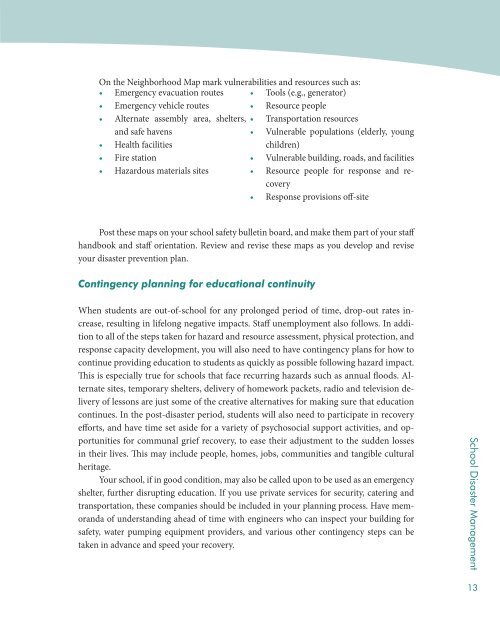Disaster and Emergency Preparedness: Guidance for ... - INEE Toolkit
Disaster and Emergency Preparedness: Guidance for ... - INEE Toolkit
Disaster and Emergency Preparedness: Guidance for ... - INEE Toolkit
Create successful ePaper yourself
Turn your PDF publications into a flip-book with our unique Google optimized e-Paper software.
On the Neighborhood Map mark vulnerabilities <strong>and</strong> resources such as: <strong>Emergency</strong> evacuation routes Tools (e.g., generator) <strong>Emergency</strong> vehicle routes Resource people Alternate assembly area, shelters, Transportation resources<strong>and</strong> safe havens Vulnerable populations (elderly, young Health facilitieschildren) Fire station Vulnerable building, roads, <strong>and</strong> facilities Hazardous materials sites Resource people <strong>for</strong> response <strong>and</strong> recovery Response provisions off-sitePost these maps on your school safety bulletin board, <strong>and</strong> make them part of your staffh<strong>and</strong>book <strong>and</strong> staff orientation. Review <strong>and</strong> revise these maps as you develop <strong>and</strong> reviseyour disaster prevention plan.Contingency planning <strong>for</strong> educational continuityWhen students are out-of-school <strong>for</strong> any prolonged period of time, drop-out rates increase,resulting in lifelong negative impacts. Staff unemployment also follows. In additionto all of the steps taken <strong>for</strong> hazard <strong>and</strong> resource assessment, physical protection, <strong>and</strong>response capacity development, you will also need to have contingency plans <strong>for</strong> how tocontinue providing education to students as quickly as possible following hazard impact.This is especially true <strong>for</strong> schools that face recurring hazards such as annual floods. Alternatesites, temporary shelters, delivery of homework packets, radio <strong>and</strong> television deliveryof lessons are just some of the creative alternatives <strong>for</strong> making sure that educationcontinues. In the post-disaster period, students will also need to participate in recoveryef<strong>for</strong>ts, <strong>and</strong> have time set aside <strong>for</strong> a variety of psychosocial support activities, <strong>and</strong> opportunities<strong>for</strong> communal grief recovery, to ease their adjustment to the sudden lossesin their lives. This may include people, homes, jobs, communities <strong>and</strong> tangible culturalheritage.Your school, if in good condition, may also be called upon to be used as an emergencyshelter, further disrupting education. If you use private services <strong>for</strong> security, catering <strong>and</strong>transportation, these companies should be included in your planning process. Have memor<strong>and</strong>aof underst<strong>and</strong>ing ahead of time with engineers who can inspect your building <strong>for</strong>safety, water pumping equipment providers, <strong>and</strong> various other contingency steps can betaken in advance <strong>and</strong> speed your recovery.School <strong>Disaster</strong> Management13
















